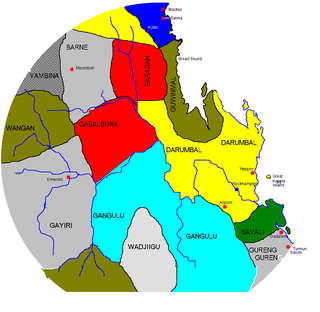History of contact
The Bakanambia were one of the 'mobs' (the others being the Kokowara and Mutumui) that attacked Edmund Kennedy's exploratory party as it passed through their territory. The principal informant for the language of the Princess Charlotte Bay area, as jotted down by a local resident, W. O. Hodginson and cited by Edward Micklethwaite Curr, and indexed as bearing on the Bakanambia by Norman Tindale, was a 10-year-old boy nicknamed Mal by the couple who kidnapped him. Curr notes the circumstances and adds that:
'it is not at all an unusual circumstance in North Queensland for a boy of tender years to be seized by a White man, taken away from his tribe and country, and brought up ass a stockman or station hand, in which capacity his excellent sight and powers of tracking animals render him specially useful.'

The Gangulu people, also written Kangulu, Kaangooloo, Ghungalu and other variations, are an Aboriginal Australian people from the Mount Morgan area in Queensland, Australia.
The Barungguan are an Aboriginal Australian people of the Cape York Peninsula of Northern Queensland. The name is associated with three languages: Ganganda, Umpithamu and Morrobolam.
The Tulua people were an Aboriginal Australian people of Queensland, in the southern to central region from the coast to the ranges. The Dappil and Tulua people possibly spoke the same language.
The Gia people, also known as Giya, Kia, Bumbarra, and variants, are an Aboriginal Australian people of the state of Queensland. Little is known of them.
The Amangu are an indigenous Yamatji people of the mid-western region of Western Australia.
The Wudjari were an Aboriginal Australian people of the Noongar cultural group of the southern region of Western Australia.
The Maia were an indigenous Australian tribe of Western Australia.
The Mutumui were an indigenous Australian people of northern Queensland.
The Dingaal people, also known as Walmbarddha or Walmbaria, are an Aboriginal Australian people of Cape York Peninsula in northern Queensland.
The Wakabunga are an indigenous Australian people of the state of Queensland.
The Marrago were an Aboriginal Australian people of the state of the Cape York Peninsula in northern Queensland. They may have been a subgroup of the Mayi-Kutuna.
The Gugu Rarmul were an indigenous Australian people of the state of Queensland, one of several whose speech was called Gugu Yawa.
Yadaneru, also written Jeteneru, refers to a tribe at one time thought to have existed in the Cape York Peninsula of northern Queensland.
The Ringaringa (Ringu-Ringu) were an indigenous Australian people of the state of Queensland.
The Yanda were an indigenous Australian people of the state of Queensland.
The Rungarungawa were an indigenous Australian people of the state of Queensland.
The Yilba, also written Ilba and Jilba, are or were an Aboriginal Australian people of the present-day state of Queensland.
The Yagalingu are an Aboriginal Australian people of the state of Queensland. Their language may have been a dialect of Bidjara.
The Kunggara, also known as Kuritjara, are an indigenous Australian people of the southern Cape York Peninsula in Queensland.
The Kokomini (Gugumini) are reported to have been an indigenous Australian people of the state of Queensland, though some indications suggest the term may refer to a loose confederation of tribal groups.
This page is based on this
Wikipedia article Text is available under the
CC BY-SA 4.0 license; additional terms may apply.
Images, videos and audio are available under their respective licenses.
